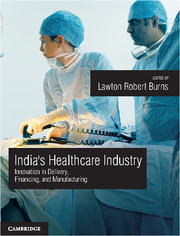Book contents
- Frontmatter
- Contents
- List of Figures
- Preface
- Acknowledgments
- SECTION I Introduction: Lenses and Frameworks for Analyzing India's Healthcare System
- SECTION II Providers: Delivery of Healthcare Services
- 4 The Medical Profession in India
- 5 India's Hospital Sector: The Journey from Public to Private Healthcare Delivery
- 6 Medical Tourism: Opportunities and Challenges
- 7 The Aravind Eye Care System
- 8 The Real Deal at L V Prasad Eye Institute: Excellence and Equity in Healthcare
- 9 Vaatsalya Healthcare: Promoting Access to Healthcare in Rural and Semi-Urban India
- SECTION III Payers: Financing of Healthcare Services
- SECTION IV Producers: Manufacturers of Healthcare Technology
- Contributors
- Index
7 - The Aravind Eye Care System
Published online by Cambridge University Press: 05 June 2014
- Frontmatter
- Contents
- List of Figures
- Preface
- Acknowledgments
- SECTION I Introduction: Lenses and Frameworks for Analyzing India's Healthcare System
- SECTION II Providers: Delivery of Healthcare Services
- 4 The Medical Profession in India
- 5 India's Hospital Sector: The Journey from Public to Private Healthcare Delivery
- 6 Medical Tourism: Opportunities and Challenges
- 7 The Aravind Eye Care System
- 8 The Real Deal at L V Prasad Eye Institute: Excellence and Equity in Healthcare
- 9 Vaatsalya Healthcare: Promoting Access to Healthcare in Rural and Semi-Urban India
- SECTION III Payers: Financing of Healthcare Services
- SECTION IV Producers: Manufacturers of Healthcare Technology
- Contributors
- Index
Summary
Introduction
The Aravind Eye Care System (Aravind) is a massive network of ophthalmologic hospitals and primary eye care centers in the state of Tamil Nadu in southern India, joined by educational and research institutes, community outreach programs, an eye bank, and a manufacturing arm for lenses. Aravind is famous for its immense contributions to provision of healthcare to the poor. Over the course of its history, Aravind has treated millions of impoverished people in need of eye care. Most remarkably, Aravind has found ways to deliver this care in a financially profitable way.
This history constitutes one of the greatest success stories of providing business solutions to the “bottom of the pyramid,” or BOP (see Chapter 11). The BOP refers to the poorest and largest segment of the population. This is a challenging population segment to serve for several reasons: they have been traditionally underserved, and thus have greater healthcare needs; they have few resources (both capital and human capital); they are a dispersed and heavily rural population; and they enjoy few logistical supports to access care. As a result, the BOP has traditionally not been seen as a favorable customer base. Recently, however, they have begun to attract attention as a viable target for generating revenues and profits. Serving them requires unconventional and innovative strategies.
Aravind's experience in serving this segment has provided both inspiration and valuable lessons for healthcare providers throughout the developing world who wish to reach out to the impoverished masses. This chapter chronicles Aravind's past and present roles in the Indian healthcare space, drawing implications both for Aravind as it looks into the future and for other organizations that wish to provide healthcare to the bottom of the pyramid.
- Type
- Chapter
- Information
- India's Healthcare IndustryInnovation in Delivery, Financing, and Manufacturing, pp. 290 - 316Publisher: Cambridge University PressPrint publication year: 2014
- 1
- Cited by



